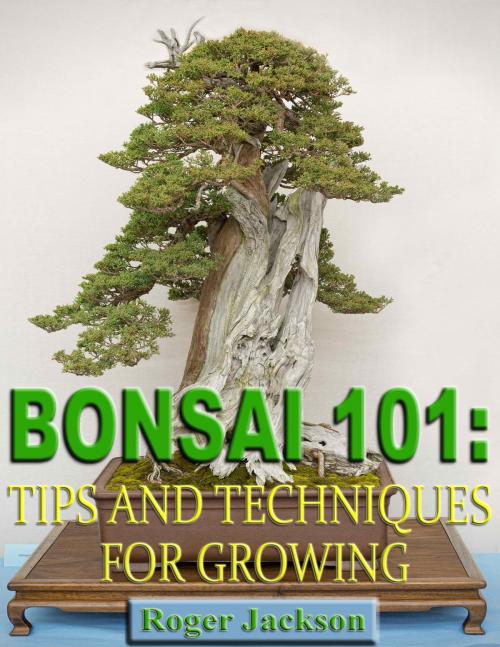Bonsai 101: Tips and Techniques for Growing
Nonfiction, Home & Garden, Gardening, Japanese Gardens, Ornamental Plants, House Plants| Author: | Roger Jackson | ISBN: | 1230000135426 |
| Publisher: | P Maldonado | Publication: | May 24, 2013 |
| Imprint: | Language: | English |
| Author: | Roger Jackson |
| ISBN: | 1230000135426 |
| Publisher: | P Maldonado |
| Publication: | May 24, 2013 |
| Imprint: | |
| Language: | English |
Bonsai 101: Tips and Techniques for Growing
Do not 'buy a bonsai'. That is a poor way to begin this remarkable hobby and usually doomed to failure. Bonsai is not about 'owning' bonsai plants, but rather the satisfaction of taking care of them and specifically developing them.
One finds out the essentials of bonsai best by creating them, even your first one. Without these basics, it is unreasonable to expect that somebody could keep one alive, let alone maintaining it as art. There is likewise the cost aspect. Any 'real' bonsai will take at least five years of advancement to be persuading. To get such a bonsai would cost several hundred dollars. Of course you can find 'shopping center bonsai' everywhere, even supermarket. These are junk, they are not bonsai. A 2 year old juniper cutting plunked unceremoniously into a bonsai pot is not bonsai. It is the care and training that makes bonsai; these plants have none.
If this seems daunting, well, it is. It takes years to find out most bonsai skills, well, 2 years to find out the basics anyhow. Styling skills are discovered over a life time. Well then, how do you begin? First and foremost read as much as you can find about bonsai. My internet site is an excellent start, there are many others. Join the Internet Bonsai Club. The instructions go to Links. Following appearance at as many bonsai as you can, even if just pictures. Many images are readily available online, examine them seriously. Try to determine simply what it is that you like about them. Till you can envision bonsai, you will not be able to produce one. But you can start by copying and following the Rules. Get a book or two, first an easy book, like Sunset's "Bonsai", then a great book like John Naka's "Bonsai Techniques I".
Begin as soon as possible. Purchase one gallon baby room plants that look intriguing and start training them. Don't even repot them. This is very important. Practically all novices are impatient to get them in bonsai pots. Good bonsai don't enter into bonsai pots till they are basically finished. Completed is a relative term in bonsai due to the fact that they are never ever truly "finished". Don't pot it up until the trunk has actually reached the size and shape that you desire. This is after a minimum of a couple of years of training; the finest and biggest don't go into pots till after twenty years or even more. If you work on the roots as soon as possible, you will kill it outright. However by working on the top you will learn a few of the pruning, wiring, and styling techniques, and will actually prepare it for its first root pruning. It could die anyway, so be prepared for that. It is a necessary part of discovering. After a year or two you will have some inclination about ways to handle the roots, so don't fret about that now.
Take this baby room plant and design the upper section of the plant by pruning. What you do and the amount of you eliminate will hinge on the time of the year, however if you go slowly and do not eliminate even more than about a 3rd of the foliage in any one session (with a few months recovery between), you will be pretty safe. Your plant needs to flourish and become compact. Slowly it will begin to look even more like bonsai and less like a shrub. There are numerous, lots of, tricks and strategies to pruning and styling. You can find out these by checking out about bonsai, however mainly by looking at them and aesthetically examining them.
Among the first things you will see is that all of them have a definite trunk line. It usually will be a solitary trunk, however often there will be a dominant trunk and a secondary trunk. Seldom will there be even more than 2 trunks other than for team or forest designs. Your baby room plant will have numerous trunks and branches if it is a shrub, but a single trunk if it is a young tree.
I suggest that you get a shrubby plant first; it will provide you more to do from the really starting. Among your first jobs will be to find a trunk line. You will need to visually remove all the unneeded trunks and branches to see the trunk line. In reality this needs to be the basis for the selection of the plant in the nursery. In a shrubby plant there is hardly ever just one 'bonsai' in a plant. Your job is to find the most pleasing trunk line. It most likely will not be straight but rather curved with flowing movement.
Bonsai 101: Tips and Techniques for Growing
Do not 'buy a bonsai'. That is a poor way to begin this remarkable hobby and usually doomed to failure. Bonsai is not about 'owning' bonsai plants, but rather the satisfaction of taking care of them and specifically developing them.
One finds out the essentials of bonsai best by creating them, even your first one. Without these basics, it is unreasonable to expect that somebody could keep one alive, let alone maintaining it as art. There is likewise the cost aspect. Any 'real' bonsai will take at least five years of advancement to be persuading. To get such a bonsai would cost several hundred dollars. Of course you can find 'shopping center bonsai' everywhere, even supermarket. These are junk, they are not bonsai. A 2 year old juniper cutting plunked unceremoniously into a bonsai pot is not bonsai. It is the care and training that makes bonsai; these plants have none.
If this seems daunting, well, it is. It takes years to find out most bonsai skills, well, 2 years to find out the basics anyhow. Styling skills are discovered over a life time. Well then, how do you begin? First and foremost read as much as you can find about bonsai. My internet site is an excellent start, there are many others. Join the Internet Bonsai Club. The instructions go to Links. Following appearance at as many bonsai as you can, even if just pictures. Many images are readily available online, examine them seriously. Try to determine simply what it is that you like about them. Till you can envision bonsai, you will not be able to produce one. But you can start by copying and following the Rules. Get a book or two, first an easy book, like Sunset's "Bonsai", then a great book like John Naka's "Bonsai Techniques I".
Begin as soon as possible. Purchase one gallon baby room plants that look intriguing and start training them. Don't even repot them. This is very important. Practically all novices are impatient to get them in bonsai pots. Good bonsai don't enter into bonsai pots till they are basically finished. Completed is a relative term in bonsai due to the fact that they are never ever truly "finished". Don't pot it up until the trunk has actually reached the size and shape that you desire. This is after a minimum of a couple of years of training; the finest and biggest don't go into pots till after twenty years or even more. If you work on the roots as soon as possible, you will kill it outright. However by working on the top you will learn a few of the pruning, wiring, and styling techniques, and will actually prepare it for its first root pruning. It could die anyway, so be prepared for that. It is a necessary part of discovering. After a year or two you will have some inclination about ways to handle the roots, so don't fret about that now.
Take this baby room plant and design the upper section of the plant by pruning. What you do and the amount of you eliminate will hinge on the time of the year, however if you go slowly and do not eliminate even more than about a 3rd of the foliage in any one session (with a few months recovery between), you will be pretty safe. Your plant needs to flourish and become compact. Slowly it will begin to look even more like bonsai and less like a shrub. There are numerous, lots of, tricks and strategies to pruning and styling. You can find out these by checking out about bonsai, however mainly by looking at them and aesthetically examining them.
Among the first things you will see is that all of them have a definite trunk line. It usually will be a solitary trunk, however often there will be a dominant trunk and a secondary trunk. Seldom will there be even more than 2 trunks other than for team or forest designs. Your baby room plant will have numerous trunks and branches if it is a shrub, but a single trunk if it is a young tree.
I suggest that you get a shrubby plant first; it will provide you more to do from the really starting. Among your first jobs will be to find a trunk line. You will need to visually remove all the unneeded trunks and branches to see the trunk line. In reality this needs to be the basis for the selection of the plant in the nursery. In a shrubby plant there is hardly ever just one 'bonsai' in a plant. Your job is to find the most pleasing trunk line. It most likely will not be straight but rather curved with flowing movement.















